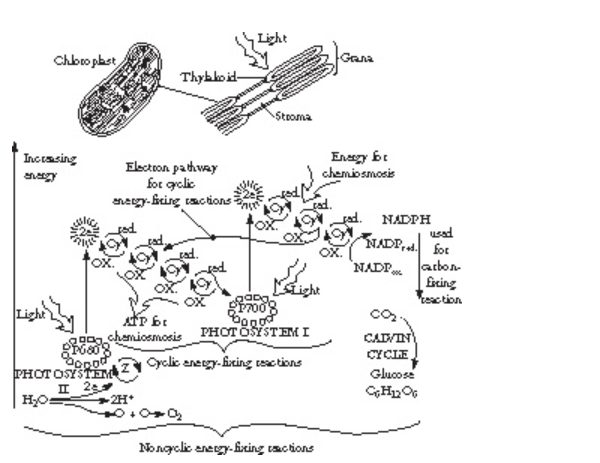Process of Photosynthesis
The process of photosynthesis is conveniently divided into two parts: the energy-fixing reaction (also called the light reaction) and the carbon-fixing reaction (also called the light-independent reaction or the dark reaction).
The energy-fixing reaction of photosynthesis begins when light is absorbed in photosystem II in the thylakoid membranes.
The energy of the sunlight, captured in the P680 reaction center, causes the electrons from P680’s chlorophyll to move to a higher, unstable energy level.
These electrons pass through a series of cytochromes in the nearby electron-transport system.
After passing through the electron transport system, the energy-rich electrons eventually enter photosystem-I.
Some of the energy of the electron is used to pump protons across the thylakoid membrane, and this pumping sets up the potential for chemiosmosis.
The spent electrons from P680 enter the P700 reaction center in photosystem I.
Sunlight activates the electrons, which receive a second boost out of the chlorophyll molecules.
There they reach a high energy level. The electrons progress through a second electron transport system, but this time there is no proton pumping.
Rather, the energy reduces NADP.
This reduction occurs as two electrons join NADP and energize the molecule.
Because NADP acquires two negatively charged electrons, it attracts two positively charged protons to balance the charges.
Consequently, the NADP molecule is reduced to NADPH, a molecule that contains much energy.
Because electrons have flowed out of the P680 reaction center, the chlorophyll molecules are left without a certain number of electrons.
Electrons secured from water molecules replace these electrons.
Each split water molecule releases two electrons that enter the chlorophyll molecules to replace those lost.
The split water molecules also release two protons that enter the cytoplasm near the thylakoid and are available to increase the chemiosmotic gradient.
The third product of the split water molecules is oxygen.
Two oxygen atoms combine with one another to form molecular oxygen (O2), which is given off as the by-product of photosynthesis; it fills the atmosphere and is used by all oxygen-requiring organisms, including plant and animal cells.
Described above are the noncyclic energy-fixing reactions (see Figure 5-2).
Certain plants and autotrophic prokaryotes are also known to participate in cyclic energy-fixing reactions.
These reactions involve only photosystem I and the P700 reaction center.
Excited electrons leave the reaction center, pass through coenzymes of the electron transport system, and follow a special pathway back to P700.
Each electron powers the proton pump and encourages the transport of a proton across the thylakoid membrane.
This process enriches the proton gradient and eventually leads to the generation of ATP.

Figure 5-2 The energy-fixing reactions of photosynthesis.
ATP production in the energy-fixing reactions of photosynthesis occurs by the process of chemiosmosis (explained in Chapter 4).
Essentially, this process consists of a rush of
Biochemists have calculated that the proton concentration on one side of the thylakoid is 10,000 times that of the opposite side of the membrane.
In photosynthesis, the protons pass back across the membranes through channels lying alongside sites where enzymes are located.
As the protons pass through the channels, the energy of the protons is released to form high-energy ATP bonds.
ATP is formed in the energy-fixing reactions along with the NADPH formed in the main reactions.
Both ATP and NADPH provide the energy necessary for the synthesis of carbohydrates that occurs in the second major set of events in photosynthesis.
Carbon-fixing reaction
Glucose and other carbohydrates are synthesized in the carbon-fixing reaction of photosynthesis, often called the Calvin cycle after Melvin Calvin, who performed much of the biochemical research (see Figure 5-3).
This phase of photosynthesis occurs in the stroma of the plant cell.
Figure 5-3 A carbon-fixing reaction, also called the Calvin cycle.
In the carbon-fixing reaction, an essential material is carbon dioxide, which is obtained from the atmosphere.
The carbon dioxide is attached to a five-carbon compound called ribulose bisphosphate.
Ribulose bisphosphate carboxylase catalyzes this reaction.
After carbon dioxide has been joined to ribulose bisphosphate, a six-carbon product forms, which immediately breaks into two three-carbon molecules called phosphoglycerate.
Each phosphoglycerate molecule converts to another organic compound, but only in the presence of ATP.
The ATP used is the ATP synthesized in the energy-fixing reaction. The organic compound formed converts to still another organic compound using the energy present in NADPH.
Again, the energy-fixing reaction provides the essential energy.
Each of the organic compounds that results consists of three carbon atoms.
Eventually, the compounds interact with one another and join to form a single molecule of six-carbon glucose.
This process also generates additional molecules of ribulose bisphosphate to participate in further carbon-fixing reactions.
Glucose can be stored in plants in several ways.
In some plants, the glucose molecules are joined to one another to form starch molecules.
Potato plants, for example, store starch in tubers (underground stems).
In some plants, glucose converts to fructose (fruit sugar), and the energy is stored in this form.
In still other plants, fructose combines with glucose to form sucrose, commonly known as table sugar.
The energy is stored in carbohydrates in this form.
Plant cells obtain energy for their activities from these molecules.
Animals use the same forms of glucose by consuming plants and delivering the molecules to their cells.
All living things on Earth depend in some way on photosynthesis.
It is the main mechanism for bringing the energy of sunlight into living systems and making that energy available for the chemical reactions taking place in cells.
Scholarship 2025/26
Current Scholarships 2025/2026 - Fully Funded
Full Undergraduate Scholarships 2025 - 2026
Fully Funded Masters Scholarships 2025 - 26
PhD Scholarships for International Students - Fully Funded!
Funding Opportunities for Journalists 2025/2026
Funding for Entrepreneurs 2025/2026
***
